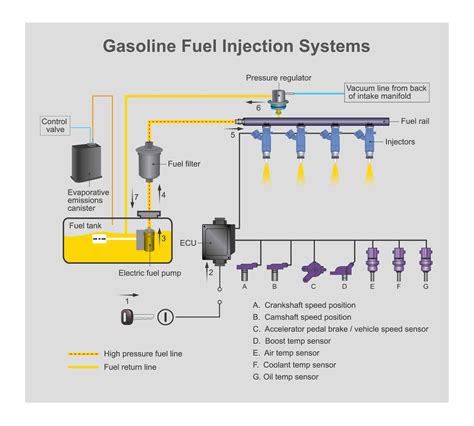Cam Timing and Fuel Injection Systems: A Detailed Look at Their Interplay
Modern internal combustion engines rely on a complex interplay between camshaft timing and fuel injection systems for optimal performance, efficiency, and emissions control. Understanding this relationship is crucial for anyone interested in automotive mechanics, engine tuning, or simply appreciating the intricate workings of a vehicle's powertrain. This article delves into the intricacies of cam timing and fuel injection systems, exploring their individual roles and how they work together.
What is Cam Timing?
The camshaft is a vital component in an internal combustion engine, responsible for controlling the opening and closing of the intake and exhaust valves. Cam timing refers to the precise timing of these valve events relative to the piston's position within the cylinder. This timing is crucial for efficient combustion and maximizing power output. Incorrect cam timing can lead to poor performance, reduced fuel economy, and increased emissions.
The camshaft's rotation is precisely synchronized with the crankshaft's rotation, usually through a timing belt or chain. This synchronization ensures the valves open and close at the optimal moments during the engine's four-stroke cycle (intake, compression, power, exhaust). Advanced camshaft designs, such as variable valve timing (VVT), allow for dynamic adjustment of cam timing to optimize performance across different engine speeds and loads.
How does Cam Timing Affect Engine Performance?
Precise cam timing is essential for several reasons:
- Optimal Valve Overlap: A carefully designed overlap between the closing of the exhaust valve and the opening of the intake valve allows for efficient scavenging of exhaust gases and improved cylinder filling with fresh air/fuel mixture.
- Improved Combustion Efficiency: Proper timing ensures the valves are open and closed at the right moments to maximize the combustion process, leading to more complete burning of the fuel and higher power output.
- Reduced Emissions: Accurate valve timing contributes to cleaner combustion, minimizing the production of harmful pollutants like unburnt hydrocarbons and nitrogen oxides.
What is a Fuel Injection System?
A fuel injection system is responsible for delivering the precise amount of fuel to the engine's cylinders at the optimal time. Unlike older carburetor systems, fuel injection offers greater control and precision, leading to improved efficiency and reduced emissions. There are various types of fuel injection systems, including:
- Port Fuel Injection (PFI): Fuel is injected into the intake manifold, near the intake valves.
- Direct Fuel Injection (DI): Fuel is injected directly into the combustion chamber.
- Multi-Point Fuel Injection (MPFI): Multiple injectors are used, one for each cylinder, offering precise fuel delivery to each cylinder individually.
How Does Fuel Injection Impact Engine Performance?
Fuel injection systems contribute significantly to engine performance through:
- Precise Fuel Delivery: Fuel injection systems deliver the exact amount of fuel needed based on engine load and speed, optimizing combustion and fuel efficiency.
- Improved Atomization: The fuel is finely atomized before entering the combustion chamber, leading to better mixing with air and more complete combustion.
- Enhanced Cold Starting: Fuel injection systems can provide a richer fuel mixture during cold starts to ensure quick engine warm-up.
The Interplay Between Cam Timing and Fuel Injection
The camshaft and fuel injection systems are intricately linked. The precise timing of valve opening and closing dictates the airflow into the cylinders, which directly impacts the amount of fuel needed for optimal combustion. Modern engine management systems constantly monitor various parameters, including engine speed, load, air temperature, and oxygen levels in the exhaust, to precisely control both cam timing (in engines with VVT) and fuel injection. This ensures that the right amount of fuel is delivered at the right time, maximizing efficiency and minimizing emissions.
How are they synchronized?
The synchronization between cam timing and fuel injection is achieved through the engine control unit (ECU). The ECU receives data from various sensors throughout the engine and uses this data to precisely control both the camshaft's position (in engines with VVT) and the fuel injectors' operation. This sophisticated control allows for dynamic adjustments based on operating conditions, resulting in optimized performance.
Frequently Asked Questions
How does variable valve timing (VVT) affect fuel economy?
VVT significantly improves fuel economy by optimizing valve timing across the engine's operating range. By adjusting valve timing to suit different engine loads and speeds, VVT allows the engine to operate more efficiently, reducing fuel consumption.
What are the common problems associated with cam timing issues?
Problems with cam timing can manifest in various ways, including poor engine performance, rough idling, misfires, and difficulty starting. In severe cases, incorrect cam timing can even damage the engine.
How often should the timing belt/chain be replaced?
The recommended replacement interval for timing belts and chains varies depending on the vehicle and engine type. Consult your vehicle's owner's manual for the manufacturer's recommended replacement schedule. Neglecting this maintenance can lead to catastrophic engine damage.
What is the difference between sequential and simultaneous fuel injection?
Sequential fuel injection injects fuel into each cylinder individually, while simultaneous injection injects fuel into multiple cylinders at the same time. Sequential injection generally provides more precise fuel delivery and improved performance.
This detailed exploration of cam timing and fuel injection systems highlights their intricate relationship and crucial roles in modern engine performance. Understanding this interplay is essential for anyone seeking a deeper comprehension of automotive technology.

